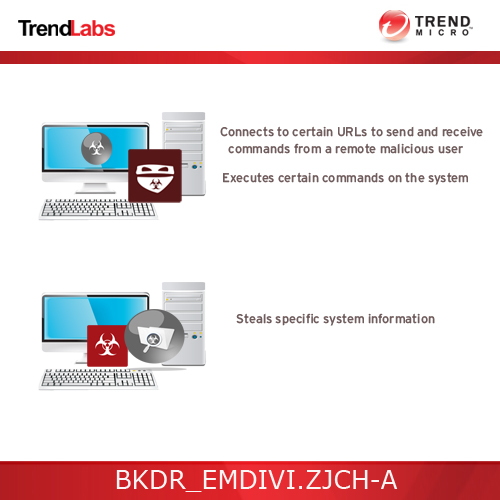BKDR_EMDIVI.ZJCH-A
Windows


Threat Type: Backdoor
Destructiveness: No
Encrypted: Yes
In the wild: Yes
OVERVIEW
Downloaded from the Internet, Dropped by other malware
This malware is related to an active campaign that compromised Japanese websites and used these as C&C servers of EMDIVI Backdoor.
To get a one-glance comprehensive view of the behavior of this Backdoor, refer to the Threat Diagram shown below.

This backdoor may arrive bundled with malware packages as a malware component. It arrives on a system as a file dropped by other malware or as a file downloaded unknowingly by users when visiting malicious sites.
It does not have any propagation routine.
It executes commands from a remote malicious user, effectively compromising the affected system.
It retrieves specific information from the affected system.
TECHNICAL DETAILS
250,702 bytes
None
Yes
24 Jul 2015
Connects to URLs/IPs, Collects system information, Compromises system security
Arrival Details
This backdoor may arrive bundled with malware packages as a malware component.
It arrives on a system as a file dropped by other malware or as a file downloaded unknowingly by users when visiting malicious sites.
Installation
This backdoor adds the following processes:
- svchost.exe
It adds the following mutexes to ensure that only one of its copies runs at any one time:
- 58e034ea0c370efbd9c8764ebf8bd197
- iL463655Oh75jM578996Pd675475
It injects codes into the following process(es):
- created svchost.exe
Propagation
This backdoor does not have any propagation routine.
Backdoor Routine
This backdoor executes the following commands from a remote malicious user:
- Enumerate files and folders
- Delete files and folders
- Download files
- Upload files
- Execute files
- Get file attributes
- Enumerate processes
- Perform remote shell
- Loads a library using LoadLibrary API
- Import functions from a library using GetProcAddress API
- Choose HTTP Authentication
- Setup Proxy auto-configuration
- Gather Firefox settings from prefs.js
- Gather proxy settings from proxy.pac
- Gather proxy settings from windows registry
- Sleep
It connects to the following URL(s) to send and receive commands from a remote malicious user:
- http://www.{BLOCKED}m.jp/index.php
- http://www.{BLOCKED}norei.com/?page={3 random numbers}
- http://jp.{BLOCKED}a.org/?p={2 random numbers}
- hxxp://2e53007.{BLOCKED}nd.com
Information Theft
This backdoor retrieves the following information from the affected system:
- Host name
- Process ID of the malware
- Memory Size (RAM)
- Internet Explorer Version
- Windows OS Version
- System Language
- Location
- Time Zone Information
Other Details
This backdoor connects to the following URL(s) to check for an Internet connection:
- http://www.msftncsi.com/ncsi.txt
- http://www.microsoft.com/en-us/default.aspx
- http://www.yahoo.co.jp
It requires the following additional components to properly run:
- {malware path}\iusb3mon.dll ← used to decrypt and load itself; detected as TROJ_EMDIVI.ZJCH-A
NOTES:
This backdoor does not execute properly if the hostname is similar to any of the following strings:
- wilbert-SC1508
- xp-sp3-template
- mip-xp-cht
- CWS01_03
- wilbert-SC2202
- dc-filesrv
- Atony-PC
- brbrb-d8fb22af1
- placehol-6f699a
It enumerates all visible windows and compares each window's title bar text with the following strings:
- OllyDbg
- W32Dasm
- Wireshark
- Fiddler
- SoftICE
- Process Explorer
- Process Monitor
- Process Hacker
If a window's title bar text contains any of the said strings, it pauses the execution of its malicious routine by performing a Sleep command.
SOLUTION
9.750
11.862.05
18 Aug 2015
11.863.00
19 Aug 2015
Step 1
Before doing any scans, Windows XP, Windows Vista, and Windows 7 users must disable System Restore to allow full scanning of their computers.
Step 2
Note that not all files, folders, and registry keys and entries are installed on your computer during this malware's/spyware's/grayware's execution. This may be due to incomplete installation or other operating system conditions. If you do not find the same files/folders/registry information, please proceed to the next step.
Step 3
Remove the malware/grayware file dropped/downloaded by BKDR_EMDIVI.ZJCH-A. (Note: Please skip this step if the threat(s) listed below have already been removed.)
- TROJ_EMDIVI.ZJCH-A
Step 4
Identify and terminate files detected as BKDR_EMDIVI.ZJCH-A
- Windows Task Manager may not display all running processes. In this case, please use a third-party process viewer, preferably Process Explorer, to terminate the malware/grayware/spyware file. You may download the said tool here.
- If the detected file is displayed in either Windows Task Manager or Process Explorer but you cannot delete it, restart your computer in safe mode. To do this, refer to this link for the complete steps.
- If the detected file is not displayed in either Windows Task Manager or Process Explorer, continue doing the next steps.
Step 5
Scan your computer with your Trend Micro product to delete files detected as BKDR_EMDIVI.ZJCH-A. If the detected files have already been cleaned, deleted, or quarantined by your Trend Micro product, no further step is required. You may opt to simply delete the quarantined files. Please check this Knowledge Base page for more information.
Did this description help? Tell us how we did.

